Woodland wildlife
From majestic red kites swooping over the trees, to tiny beetles scurrying through the undergrowth, the woodlands of the Chilterns are alive with wildlife! Explore our woods through the seasons to find out where to go for wildlife, what to spot and what’s rare.
There are lots of great woodlands to visit in the Chilterns AONB, such as Ashridge Estate, Burnham Beeches nature reserve, Wendover Woods and Cowleaze Woods. Visit our interactive map to discover even more family days out and wildlife adventures across the Chilterns.
Our woods and trees are very special, playing a huge role in the wider landscape and our own lives. Visit our nature and wildlife section to find out why these things are important in the Chilterns and what we are doing to look after them.
Watching woodland wildlife through the seasons
Read our season-by-season guide to the best Chilterns wildlife.

Spring
In spring, our woodlands come back to life after the long winter. Trees come into leaf, with cherry and field maple appearing earliest in the season, followed later by beech, oak and ash. This is a great time to look for woodland flowers. Primroses and wood sorrel flower early, followed by bluebells, which are at their best in late April and early May depending on how mild the weather has been. The first butterflies appear, such as orange-tips and commas. Birds and animals are preparing to breed: listen out for bird song, and look out for birds and animals gathering material for their nests and dens.
What to look for in Spring
Bluebell (Hyacinthoides non-scripta)
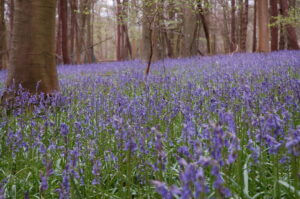
Bluebells form stunning carpets of blue in ancient woods, where the soil is deep and moist. Despite growing in large patches, they spread relatively slowly, with seeds taking several years to develop into flowering plants. Native English bluebells are bright blue, have bell-like flowers on one side of the stem and a strong scent. Non-native Spanish bluebells (Hyacinthoides hispanica) are paler, have flowers on both sides of the stem, and have less scent. The two species can hybridise.
Great spotted woodpecker (Dendrocopos major)
The great spotted woodpecker is the most common woodpecker in Chilterns’ woodlands. It is around 22 cm long, black and white, with a bright red patch under the tail. Males also have a red patch at the back of the head. Listen out for these woodpeckers ‘drumming’ away at tree trunks during spring breeding displays. They probe tree bark for insects to eat and nest in tree holes. Two other species of woodpecker can be found in the Chilterns: the green woodpecker (Picus viridis), which feeds on ants on the ground; and the lesser spotted woodpecker (Dendrocopos minor), which is a rare, small, black-and-white bird.
Tawny owl (Strix aluco)
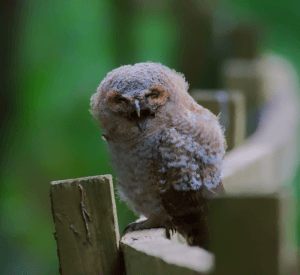
Tawny owls are the largest common owl in the UK, with a wingspan of around 1 m. Their plumage is chestnut-brown, with grey and brown streaks, and they have round faces with black eyes. Tawny owls are mainly nocturnal. Listen out for them calling with a shrill ‘kewick’, or a distinctively owlish ‘twit-twoo’ – which is actually a duet between a male and female, who will bond for life. They nest in tree holes, laying two to four eggs in late March or early April. They feed on small birds and mammals, such as voles and mice, which they locate using their excellent hearing.
Wild cherry (Prunus avium)
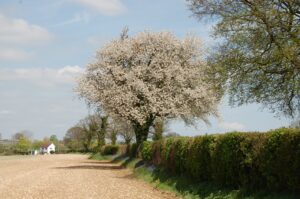
Cherry trees blossom in April and the cherries ripen in summer. Look out for piles of cherry stones around the base of cherry trees – leftovers from mice and voles enjoying the delicious fruit. Cherry trees are easy to recognise by their red-brown bark, which peels in horizontal bands. In the Chilterns, the wood of the cherry was once used to make fine furniture: find out more about furniture-making in the Chilterns.
Summer
Beech trees cast a dark shade in summer, so few plants are able to grow under mature stands, giving this type of woodland its unique feel. The bare ground is covered in fallen leaves from the year before, along with mosses, ferns and a few shade-loving plants. It is cooler in these woods, so they are good places to visit in the heat of the summer. Woodlands can seem quiet at this time of year as birds are feeding young, rather than noisily defending their territories. But with the lighter evenings, watch out for other animals busily searching for food, such as young badgers.

What to look for in Summer
Firecrest (Regulus ignicapillus)

Closely related to the goldcrest (Regulus regulus), the firecrest is a tiny kinglet bird. First recorded as breeding here in the 1960s, it can now be found in many coniferous woods of southern England. In winter, these residents are joined by migrant birds. Firecrests have olive-green backs and white bellies, and black-and-white eye-stripes. Males have an orange crown edged with black, while females have a yellow-and-black crown. Spot them flitting about between the trees in search of insect-prey.
Noctule bat (Nyctalus noctula)
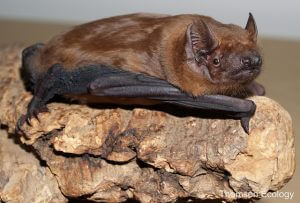
Noctule bats are one of the UK’s largest bats, with a body length of around 8 cm and a wingspan up to 45 cm. On summer evenings, they emerge early from their roosts in tree holes, ready to feed on moths, beetles and other flying insects. They fly fast and high above the ground, hunting using echolocation (the bouncing echoes of their own calls give them information about their surroundings). They mate between August and October, then hibernate over winter. Females move to nursery roosts the following May and give birth to a single pup in July.
Speckled wood butterfly (Pararge aegeria)
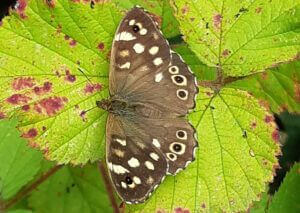
Woodland butterflies, such as the speckled wood, thrive in sunny glades and along woodland rides. They can often be seen competing for patches of sunlight where wildflowers and grasses grow, taking advantage of the break in the canopy. Their caterpillars feed on grasses, but the adults feed on honeydew produced by aphids. Many moth species are also found in woodlands, some feeding on trees, such as oaks, when in their caterpillar stages.
Stag beetle (Lucanus cervus)
Shiny black stag beetles can be found in Chilterns’ woodlands, but they are quite rare. The males use their 5-cm long, antler-like jaws to fight rivals. Males can be up to 7.5 cm long and can be seen flying at dusk as they search for mates. Females have smaller mandibles and are often spotted on the ground, looking for somewhere to lay their eggs. Stag beetles are one of many invertebrate species that feed on soil and rotting vegetation. They are an important part of the food chain, helping to break down dead wood detritus, while, in turn, providing food for badgers and other animals.

Autumn
The familiar and beautiful autumnal leaf colours of red, orange, gold and brown are at their best between late October and November. These colours are even stronger after a hot, dry summer. You can identify trees by the colour of their leaves: beech turns bronze; hornbeam goes yellow then brown; field maple turns yellow; and wild cherry turns red. This is also the time when many trees and shrubs produce their fruits – adding more colour to the season and a tasty feast for birds, animals and humans alike.
What to look for in Autumn
Beech (Fagus sylvatica)
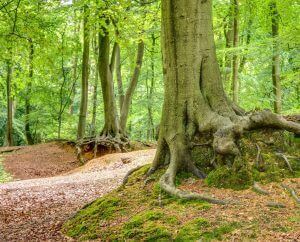
Beech trees produce seeds in autumn, held inside small, woody, bristled husks – this is known as mast. In October, the husks split apart and peel back to reveal a pair of three-sided nuts. Seeds are produced in large quantities only every five or six years; during these ‘mast years’, each tree will produce thousands of nuts. Woodpigeons, mice and voles all like to eat the mast, so, a bumper crop increases the chance of germination.
Fly agaric (Amanita muscaria)
Familiar as the iconic ‘fairy toadstool’, the fly agaric is easily identified with its bright red, white-spotted cap and bright-white stem. It is typically found growing beneath birch trees or pines. Like most fungi, the parts above ground are just the fruiting bodies. These grow from an unseen network of tiny filaments and produce spores for reproduction. Fungi help to decompose rotting wood and recycle its nutrients back into the soil. Many fungi also help trees to feed on nutrients in the soil, their filaments forming a beneficial relationship with the tree’s roots. Do remember that fly agarics and many other fungi are poisonous and should not be picked or eaten.
Jay (Garrulus glandarius)
Jays are colourful members of the crow family: mostly light brown, with a black-and-white tail and a brilliant blue flash on their wings. They help spread oak trees by collecting acorns and burying them in the grass. They retrieve some for food later, but many start to grow. Some jays fly here from Scandinavia in autumn, adding to our native population.
Roe deer (Capreolus capreolus)
There are six species of deer in the UK, but only two are truly native: roe deer and red deer (Cervus elaphus). The other species were introduced by humans in the past. Roe deer are small, red-brown deer, with distinctive buff-coloured rumps and short antlers. They frequent woodlands in the Chilterns and can be easily spotted in autumn as the trees become bare. Males grow antlers in November, shedding the velvet from them in spring, ready for the summer rutting season. Roe deer eat leaves, grasses and ferns.
Winter
Broadleaved trees like beech and oak lose their leaves for the winter, making this a good time of year to see the shapes and forms of different trees. Even without leaves, it’s possible to identify trees just from their bark, twigs, buds and general shape. Woodland animals have different ways of coping through the winter months: some, such as bats, dormice and hedgehogs, go into hibernation while others, such as squirrels, use stores of nuts they’ve collected through the autumn. Birds often struggle to find enough food, so hedgerow and woodland species may visit gardens. As the vegetation dies back, look out for the evidence of past human activities in woodlands, such as quarrying, sawpits and boundary banks.

What to look for in Winter
Fallow deer (Dama dama)

There are six species of deer in the UK, but only two are truly native. It is thought that fallow deer were first introduced by the Normans, and have since become naturalised. Look out for medium-sized herds of pretty, white-spotted deer. Fallow deer stand about 95 cm at the shoulder and only the bucks (males) have antlers, which have broad, flattened tips. The bucks and does (females) with young tend to stay apart, except during the rutting season in October. They like to eat the shoots of young trees, which can cause the trees to die.
Holly (Ilex aquifolium)
Holly is increasing in many woodlands in the Chilterns, probably due to the warming climate as holly is sensitive to frosts. This evergreen is easy to recognise with its tough, glossy, spiky leaves. In winter, the familiar red berries appear, providing a feast for birds who help to spread the plant in return. Holly has separate sexes, and berries only occur on female bushes. Holly wood is used to make inlays for fine furniture: find out more about furniture-making in the Chilterns.
Robin (Erithacus rubecula)
Although robins are generally associated with winter and Christmas, they can be seen in Chilterns’ woods all year-round. They are about 14 cm long and adults sport the famous red breast. They feed on insects, snails and worms, and breed in hollow stumps or crevices, which they defend fiercely. The robin’s slightly mournful song is a distinctive sound of winter.
Siskin (Spinus spinus)
This attractive yellow-and-green striped finch is a common sight in coniferous and mixed woods, but also visits bird tables and gardens. Males have a bright yellow chest and face, and a black cap, whereas females are a duller grey-green and don’t sport the cap. Females build their nests high up in the trees, using twigs, lichen and feathers, and incubate the eggs alone; however, males will help to feed the chicks when they hatch. Breeding residents are joined by European birds in winter.
Woodlands under threat
Woodlands are naturally growing and evolving. Yet, a lack of appropriate management means that important species and habitats are being lost at an alarming rate. There are many other threats to the survival of our woodland heritage, too, including climate change, disease and pollution. Find out how we are tackling these threats and how you can help.


Managing the Chilterns’ special habitats
Woodlands and other habitats in the Chilterns need protection, management and restoration, so that the wildlife living there can thrive and for our own well-being, too. The Chilterns Conservation Board (CCB) looks after the Chilterns AONB, working with partners and stakeholders to ensure its future. Find out what we do and how we protect, enhance and restore our wonderful landscape.

Board Meetings
Follow the Countryside Code

Featured walks
Plan your trip to the Chilterns!




